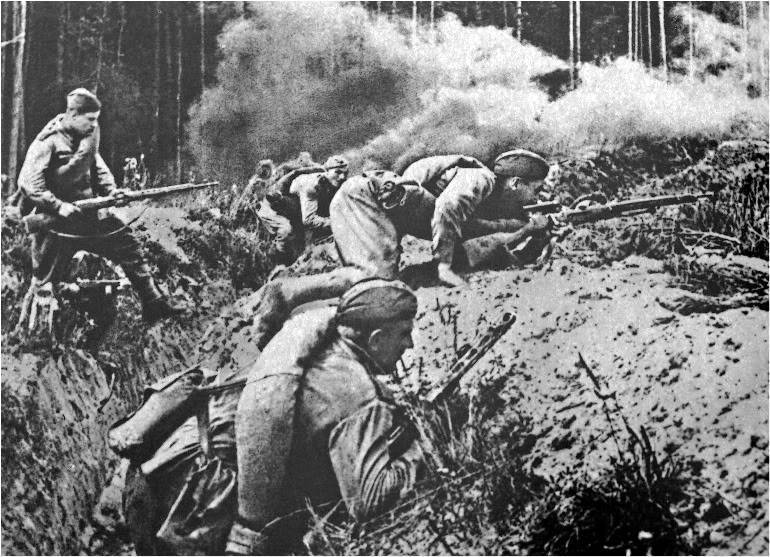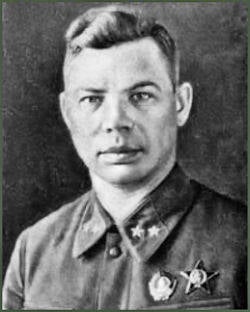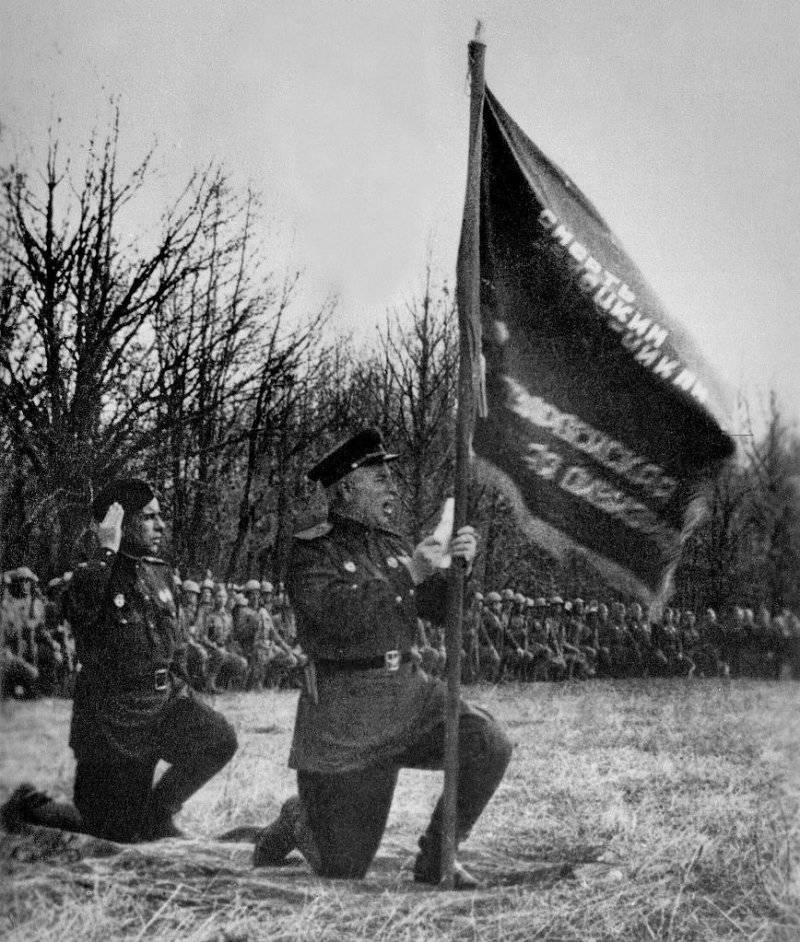Daily routine of one army near Kursk (70 army)

 During the Battle of Kursk as part of the Red Army, units and formations formed from the personnel of the internal troops took part. In October 1942, the State Defense Committee instructed the People's Commissariat of Internal Affairs to form a separate army of the NKVD troops. The commander of the army was appointed Major General GF. Tarasov, Chief of Staff - Major General V.M. Sharapov, head of the political department - Col. Ya.E. Maslovsky. All of them had previously served in the troops of the NKVD, they knew well the level of their combat training, organizational skills of commanders. The task set by the T-bills was completed in a short time.
During the Battle of Kursk as part of the Red Army, units and formations formed from the personnel of the internal troops took part. In October 1942, the State Defense Committee instructed the People's Commissariat of Internal Affairs to form a separate army of the NKVD troops. The commander of the army was appointed Major General GF. Tarasov, Chief of Staff - Major General V.M. Sharapov, head of the political department - Col. Ya.E. Maslovsky. All of them had previously served in the troops of the NKVD, they knew well the level of their combat training, organizational skills of commanders. The task set by the T-bills was completed in a short time.The army was formed from the personnel of the NKVD troops, while the internal troops allocated 16750 people. , border - 28444 people. (according to the GKO Resolution it was prescribed to allocate 29750 people) and the troops of the NKVD for the protection of railway structures - 8500 people. From the NGOs to the formation of the army should have been allocated 15000 people. ordinary and commanding officers of artillery, communications, engineering troops and other specialists, however, in fact, about 3000 people were received. At the time of the transfer of the army in the Red Army, the number was 69236 people.
By the end of January 1943, 5 divisions were formed: the Ural, Siberian, Central Asian, Trans-Baikal, Far Eastern and some individual units. The first two divisions were formed from the personnel of the internal troops, the basis of the other three consisted of soldiers and commanders of the border troops. The army also included the 10-I order of Lenin's rifle division of internal troops, distinguished themselves in the Battle of Stalingrad and reformed in Chelyabinsk. She was called Stalingrad.
At the beginning of February 1943, by order of the Supreme Command Headquarters of the Red Army, was sent to the town of Yelets, at the disposal of the commander of the forces of the Central Front. 13 February it was transferred from the NKVD to the Red Army and received the name 70-I army. Divisions were called small and called: 102-I. 106 140-i Siberian. 162 175-I Ural, 181-I Order of Lenin Stalingrad.
After short offensive actions in the first half of March, the 1943 of the year, the 70 Army, like other formations, on the orders of the Central Front Commander, Army General K. K. Rokossovsky moved to the defense on the northern ledge of the Kursk Bulge.
3 of the month were preparing troops to meet the enemy. The hard work to improve the defense, able to withstand the massive strikes of fascist tank groups, did not weaken day or night. By the beginning of the fighting, the area where the Soviet troops occupied positions was thoroughly prepared in engineering terms, the military equipment was safely hidden. Tens of thousands of anti-tank and anti-personnel mines were laid in front of the front edge and in the depth of defense. All this further contributed to strengthening the defense, reducing losses among personnel.
At the same time, subunits and units, fighters, and commanders strenuously engaged in combat training, preparing for a difficult struggle with the enemy, especially with his tanks. Vulnerabilities of fascist "tigers" and "Ferdinands" were studied, soldiers were run-in with tanks, experienced front-line soldiers taught comrades how to use anti-tank grenades and incendiary bottles to destroy enemy armored vehicles. All this was useful to our soldiers in fierce subsequent and bloody battles.
At dawn of 7, the soldiers of the 140 Siberian Rifle Division took up the blow of superior enemy forces. 4 infantry and 1 tank divisions, a jaeger battalion, attacked their positions. The fascists rushed to Kursk.
July 7-10, a fierce battle thundered, not calming down for a minute, not day or night. Enemy aviation, covering its ground forces, brought down thousands of tons of metal every day at the division’s position. The earth was pitted with funnels from bombs and shells, each span of it was dotted with fragments.
Fighters and commanders fought courageously and selflessly. The battery artillery commanded by Senior Lieutenant I.M. Kuzyukov. By participating in the repulse of the enemy’s massive tank attacks, they burned and destroyed 30 tanks. The wounded soldiers did not leave their positions, but continued to fight while they were strong. The gun crew of the senior sergeant Vasily Pody was especially distinguished by his courage and martial skills.
It was the fourth hour of uninterrupted combat. The calculation is already destroyed 4 fascist tank. On the position of the gunners struck a bomb strike. The boxes with shells caught fire, and V. Pod was wounded by shrapnel. But he did not leave the cannon, knocked down the flames and carried boxes of ammunition. And then again fire at the enemy. The fifth German tank was also shot down.
The Nazis tried to circumvent artillery positions from the rear, but the calculation of V. Pody quickly deployed a gun and set fire to two more tanks at close range. For two days of fighting (7 and 8 July), his gun crew knocked out and set fire to 13 tanks, destroyed the Nazis to 50.
Heroic acted gunners and other parts. Thus, the 76-mm battery is commanded by Senior Lieutenant A.P. Voloshin of the 181-th Order of Lenin of the Stalingrad Division, with a breakthrough of the enemy's defense, knocked out two tanks. Continuing the attack by rolling over two guns, the gunners ran into the enemy’s tank ambush. Two guns were hit immediately, and then the third gun was put out of action. With the remaining cannon and the rifle company that arrived in time, the artillerymen occupied the perimeter defense. When the German tank left the ambush, they knocked him out, and then took up the machine guns and, together with the infantrymen, beat off three enemy counterattacks. For this fight A. Voloshin was awarded the Order of the Red Banner. For courage and heroism in the subsequent battles, 16 of October 1943 was awarded the title Hero of the Soviet Union.
Fearlessly acted gunner guns from the same division Nikolai Olchev. Reflecting the enemy’s tank attack as part of the battery, he hit the Tiger with two shots with direct fire.
Not only artillerymen successfully fought enemy tanks, but also arrows. There are many examples of this. The heavy bulk of the "tiger" fell on the trench of the corporal Patogov, but the courageous fighter did not flinch, did not lose composure. As soon as the tank passed over the trench, he got out from under the earth that had filled him, quickly jumped out of the trench-gap, caught up with the tank and threw a grenade. She got into the engine compartment, and at the same time the tank caught fire.
Enviable self-control and courage fighters armored combatants differed. They allowed the fascist tanks to close at close range and fired at the tracks and viewing slots, thus depriving the tanks of the ability to move. And our gunners dealt with fixed vehicles. For example, in one battle, an armor-piercer N. Gorgon from an anti-tank rifle interrupted the tracks in two tanks.
Despite the heavy losses in technology and manpower, the fascist troops stubbornly gnawed through the defense of parts of the 70 Army. Often there were cases when they entered the rear of the defenders, attacked command posts. During one of the battles, the enemy's single tanks penetrated into the depths of the 96 th regiment of the 140 division. One tank with a landing of machine gunners broke through to the headquarters of the regiment. The staff officers headed by the regimental commander, Colonel A.S. Grigoriev and Chief of Staff Captain B.I. Chugunov took a perimeter defense, they undermined a tank with grenades and destroyed submachine gunners.
At the same time, the regiment commander and senior lieutenant Sytnik with a group of fighters saved the regiment's relic, the Fighting Banner. Two shells hit the house where the Banner was kept. The sentry was killed. Several soldiers rushed to the building, but only ordinary Yermolenko managed to get into it. Another shell hit the house, the roof collapsed. Everything seemed to be gone - the fighter was killed. But Yermolenko managed to break through the flames, carrying in his hands the Banner, on which a fringe was already smoldering.
There were many examples of self-sacrifice. The party organizer of the 3 Company of the 96 Regiment, sergeant Peter Erypalov in a fierce hand-to-hand battle struck more than a dozen enemies, but was also wounded. The fascists surrounded the brave man, tried to capture him. They even managed to knock down Erypalov on the ground. But here, too, the fearless fighter was not taken aback. The last effort he left a grenade blew himself up and piling on the Nazis.
Fighters of division reconnaissance, commanded by Captain V.I. Atamanov, then senior lieutenant D.Z. Yudenko. In the course of the offensive of the division, the scouts were tasked to capture the language in order to establish the enemy grouping in front of the division front.
The company commander made a bold decision - to take the language in the daytime, in the morning, when, after breakfast, the Germans, as usual, rest in dugouts, leaving the machine gun to one person on duty. The capture group was headed personally by D. Yudenko. At about 9 hours the Nazis had breakfast and settled down to rest in a dugout. Corporal V.I. Lysikov secretly crawled up to the person on duty at the machine gun and silently removed it. A group of scouts broke into the dugout, destroyed the Nazis' 16, captured the non-commissioned officer and returned to the unit without losses.
The next day, the scouts were awarded. The Order of the Red Star was awarded to Vladimir Lysikov, the medal "For Courage" - P. Shcherbakov. G. Otrozhko, S. Vishnyakov, "For Military Merit" - I. Putilova.
Successfully exterminated the invaders snipers 181-th Stalingrad division, led by his mentor the holder of the Order of the Red Banner and the Red Star captain F.A. Ivanov. Only one day on July 24, snipers destroyed 19 soldiers and officers of the enemy. A few days before the attack, the company was forced to lie down under the fire of three machine guns. F. Ivanov distributed enemy machine guns between two snipers who were constantly with him, and one took over. Literally in 3 minutes, the enemy machine-gun crews were over. The captain rose with a cry: "For the Motherland, for me, forward!". His example was followed by fighters. Unfortunately, captain F. Ivanov was hit by an enemy bullet.
In the Battle of Kursk participated teams of snipers from parts of the internal troops stationed far from the fire arc - in the Volga region, in the Urals, in Siberia. At the site of the defense of one of the regiments of the 41 division of the 63 army, the team of snipers of the 90 regiment of the 26 division of the NKVD railway guard, led by senior lieutenant Alexei Prikhodko, selflessly acted.
An enemy artillery and mortar raid found a group of 8 snipers, led by foreman R. Krosubaev. in the strong point of the 6 th rifle company. When the Germans went on the attack, the snipers, together with the company fighters, bravely fought with the superior forces of the enemy. Senior warden I. Zubenko, being wounded, replaced the outdated gunner with an easel machine gun and with accurate fire destroyed dozens of nazis. Despite the injuries sustained, elder R. Krosubaev and private A. Kazansky continued to fight. Another group of snipers, led by Senior Lieutenant Prikhodko, was also bravely fighting, located in the stronghold of the 3 Company.
The Battle of Kursk was attended not only by the formations of the former Separate NKVD Army, but also by units transferred earlier from internal troops to the Red Army, in particular the 75-I Guards Rifle Division commanded by Major-General V.A. Horish. At one time it was the 13-I motorized rifle division of internal troops. In the summer of 1942, it was transferred to the Red Army along with the 8 MSD and received the name 95-sd, and for the distinction in the Battle of Stalingrad it was awarded the title of Guards and became known as the 75-th Guards Rifle Division. Guardsmen did not drop their rank in the battle of Kursk. In brutal bloody battles, the division stood to death, suffered heavy losses, but firmly held the lines it occupied. The well-known Soviet writer K. Simonov, who visited those menacing days of July 1943 at the 75 fighters of the Guards, quotes the division commander, V.A. Gorishnoy about the results of the first day of the fighting: “I lost a lot of people before 2000 and lost 48 tanks. People, I’ll just tell you, died for guns, but 50, in turn, got German tanks filled.”
Among these destroyed and burned cars were tanks set on fire by the gun, which was commanded by the junior sergeant A. Petrov. When a group of heavy enemy tanks began to unfold to attack, Petrov ordered the gun to roll forward and immediately open fire. Two tanks immediately began to smoke. The rest, firing machine guns, moved to the position of the gunners. Focusing fire on the two main machines, the calculation knocked them down, but the rest rushed right to the cannon. The calculation acted clearly and coherently: another “tiger” caught fire, then another. "Stand to the death!" - Petrov called his fighters. But the next tank rammed the cannon and crushed the brave gunners. This is how the guardsmen of the former division of the NKVD fought.
Marshal of the Soviet Union K.K. Rokossovsky, who commanded the forces of the Central Front, recalled years later: "On the Kursk Bulge, along with our other armies, successfully fought 70 Army I, formed from border and NKVD personnel. In the defense zone of this army from 5 to 12 in July 1943. (for 8 days) the enemy lost soldiers and officers to 20000, 572 was destroyed and burned by enemy tanks, 60 were tigers, 70 aircraft were shot down. These facts speak eloquently of the courage and bravery of the NKVD border guards and the NKVD division. in the 70 Army, after the The zgrom of the fascist hordes in the Battle of Kursk continued their victorious journey to the west.
181 of the Order of Lenin. The Stalingrad Division participated in the liberation of Chernigov and Korosten from invaders. Lutsk and other cities. She was awarded three more orders: the Red Banner. Suvorov II degree. Kutuzov II degree. 20 its warriors became Heroes of the Soviet Union. 5 - full holders of the Order of Glory.
140-I Siberian Rifle Division was awarded the Order of Lenin, twice the Red Banner. Suvorov II degree and Kutuzov II degree. She was awarded the honorary title of Novgorod-Severskaya. The battle Banner of the celebrated division, as an outstanding relic, is on display in the Victory Hall of the Central Museum of the Armed Forces of Russia.
The 175-I Ural Infantry Division distinguished itself in stubborn battles in the capture of the strategic railway junction in western Ukraine, Covel, which took place in the most difficult battles to Potsdam. The division was awarded the Order of the Red Banner and Kutuzov II degree, awarded the honorary title "Kovel."

Information